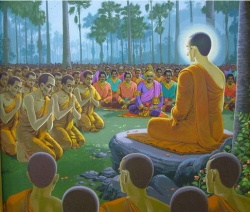Buddhist Councils
Buddhist Councils
[結集] (Skt samgiti; Jpn ketsuju )
Assemblies of monks held after Shakyamuni Buddha's death to compile and confirm the Buddha's teachings so as to ensure their accurate preservation and transmission. It is said that four such councils were held during the four hundred years following the Buddha's death. The Sanskrit samgiti means singing or reciting in unison. This reflects the method by which the Buddha's teachings were passed from one generation to the next during that period, that is, by memorization and recitation, rather than by written record.
(1) The First Buddhist Council was convened shortly after Shakyamuni's death with the support of King Ajatashatru in the Cave of the Seven Leaves near Rajagriha in Magadha, India. About five hundred monks (one thousand according to another account) participated under the leadership of Mahakashyapa. It is said that Ananda recited the sutras and Upali recited the vinaya, or monastic rules of discipline. The others confirmed the correctness of their recitation and then recited the teachings again in unison, thus establishing a definitive version.
(2) The Second Buddhist Council was held about one hundred years after the first council, when seven hundred monks led by Yasa gathered in Vaishali, India. It is therefore known also as the Gathering of Seven Hundred Monks. At that time, the monks of the Vriji tribe in Vaishaliwere advocating a more liberal interpretation of the precepts, a move that disturbed many of the older, more conservative monks. The council headed by Yasa rejected that interpretation, but controversy over this issue eventually led to the first schism in the Buddhist Order. (Tradition in Kashmir holds that it was disagreement over the five teachings of Mahadeva that provoked the schism.) See also ten unlawful revisions.
(3) The Third Buddhist Council was held with the support of King Ashoka at Pataliputra in India some one hundred years after the second council. One thousand monks under Moggaliputta Tissa assembled to clear up confusion and correct misinterpretations in the Buddha's teachings. It is said that at this assembly the abhidharma works, or commentaries and treatises, were compiled and incorporated into one of the three divisions of the Buddhist canon.
(4) The Fourth Buddhist Council was held in Kashmir, under the patronage of King Kanishka about two hundred years after the third council. Five hundred monks led by Vasumitra revised the canon and established a definitive version.The Great Commentary on the Abhidharma is attributed to this council.Accounts of these Buddhist Councils in Northern Buddhism differ slightly from those in Southern Buddhism.
